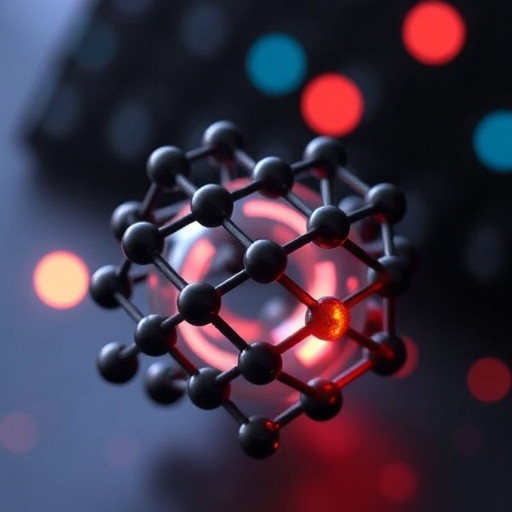In the realm of advanced materials science and catalysis, the search for efficient catalysts for oxygen reduction reactions (ORR) has taken a significant leap forward with recent developments in the synthesis of hierarchical core-shell structures. Researchers Zhou, Tang, and Zhang, along with their colleagues, have unveiled a groundbreaking technique for creating a core-shell catalyst composed of iron (Fe) and nitrogen (N)-doped carbon, which holds promise for enhancing the efficiency of ORR, a crucial reaction in various electrochemical applications, including fuel cells and metal-air batteries.
At the foundation of this innovative approach is the utilization of a surfactant known as Pluronic F127. This molecule plays a pivotal role in the synthesis process by stabilizing the formation of structures that can eventually lead to the desired core-shell morphology. The strategic incorporation of F127 not only facilitates the construction of a robust framework for the catalyst but also helps in achieving the correct orientation and distribution of the active metal sites. This is critical for maximizing catalytic activity and performance during electrocatalytic reactions.
The catalytic properties of the synthesized Fe/N-doped carbon material stem from the unique arrangement of its components. The core, made of iron, acts as the active site for the oxygen reduction reaction, while the shell composed of nitrogen-doped carbon enhances electronic conductivity and stability. This combination allows for a synergistic effect where the overall activity of the catalyst is remarkably improved compared to traditional catalyst materials. Comprehensive electrochemical studies reveal that this core-shell design not only boosts the reaction kinetics but also supports higher durability, thus addressing two critical challenges in the field of catalysis.
Through meticulous characterization techniques, the researchers have elucidated the microstructure and composition of the synthesized catalyst. Scanning electron microscopy (SEM) and transmission electron microscopy (TEM) provided insights into the morphology, revealing the distinct core and shell features that define their hierarchical structure. Meanwhile, X-ray diffraction (XRD) and X-ray photoelectron spectroscopy (XPS) analyses confirmed the successful doping of nitrogen into the carbon lattice, validating the hypothesis that N-doping is instrumental in enhancing catalytic behavior.
In addition to its promising electrochemical performance, the Fe/N-doped carbon catalyst showcases excellent thermal stability. This characteristic is essential for practical applications where catalysts are often exposed to various temperatures and environmental conditions. The robust nature of this core-shell structure ensures that it retains its integrity and performance over extended operational periods, a factor that significantly enhances its attractiveness for commercial applications in the energy sector.
The implications of this research extend beyond just enhancing the oxygen reduction reaction. The methodologies employed in synthesizing this catalyst can inspire similar approaches for developing other advanced materials. The ability to precisely engineer the properties of core-shell structures opens up a plethora of possibilities in the materials science domain, allowing for the design of tailored catalysts suited for specific applications ranging from batteries to sensors.
Moreover, the understanding derived from this study contributes significantly to the ongoing discourse surrounding sustainable energy solutions. As the world pivots towards greener technologies, efficient catalysts play a crucial role in enabling clean energy solutions. Fuel cells, powered by efficient ORR processes, can facilitate a transition away from fossil fuels, promoting a more sustainable and environmentally friendly future. This research not only marks a step forward in the field of electrochemistry but also aligns with global initiatives aimed at reducing carbon footprints and enhancing energy efficiency.
Looking ahead, further research is warranted to explore the scalability and localization of this synthesis process. While laboratory-scale successes are promising, the challenge remains to translate these findings into industrial applications where mass production and cost efficiency are paramount. Investigating alternative surfactants or precursors could yield insights into more economical pathways for synthesizing these advanced catalysts.
As the quest for effective catalysts continues, the findings presented by Zhou et al. remind us of the significance of collaboration and the multidisciplinary approaches required to propel scientific advancements. The intersection of chemistry, materials science, and engineering offers fertile ground for breakthroughs that can drive innovation in energy technologies.
Ultimately, this research serves as a beacon of hope within the scientific community, illuminating the path towards better-performing catalysts that can tackle some of the most pressing challenges faced in energy conversion and storage activities. The marriage of robust synthesis methods with strategic material design will undeniably lead to the advent of next-generation catalysts that are not only efficient but also sustainable.
Innovation in this field requires a relentless pursuit of knowledge and a willingness to explore uncharted territories. As we stand on the threshold of significant discoveries, the implications of the hierarchical core-shell Fe/N-doped carbon catalyst extend far beyond the laboratory. The quest for greener, more efficient energy systems is a collective journey, one that involves researchers, industry partners, and policymakers all aligning their efforts towards building a sustainable future powered by effective catalysts.
In summary, the groundbreaking research by Zhou, Tang, and Zhang highlights significant advancements in the synthesis of catalysts capable of enhancing the oxygen reduction reaction through hierarchical core-shell structures. With their innovative use of Pluronic F127 and the integration of nitrogen-doped carbon, these researchers have laid the groundwork for future developments in the field of catalysis, encouraging a new era of sustainable energy solutions.
Subject of Research: Hierarchical core-shell Fe/N-Doped carbon catalyst for enhanced oxygen reduction reaction.
Article Title: F127-mediated synthesis of hierarchical core–shell Fe/N-Doped carbon catalyst for enhanced oxygen reduction reaction.
Article References:
Zhou, J., Tang, Y., Zhang, L. et al. F127-mediated synthesis of hierarchical core–shell Fe/N-Doped carbon catalyst for enhanced oxygen reduction reaction. Ionics (2025). https://doi.org/10.1007/s11581-025-06781-5
Image Credits: AI Generated
DOI: https://doi.org/10.1007/s11581-025-06781-5
Keywords: Oxygen Reduction Reaction, Fe/N-Doped Carbon Catalyst, Core-Shell Structure, Electrocatalysis, Sustainable Energy, Pluronic F127, Energy Storage, Fuel Cells.




